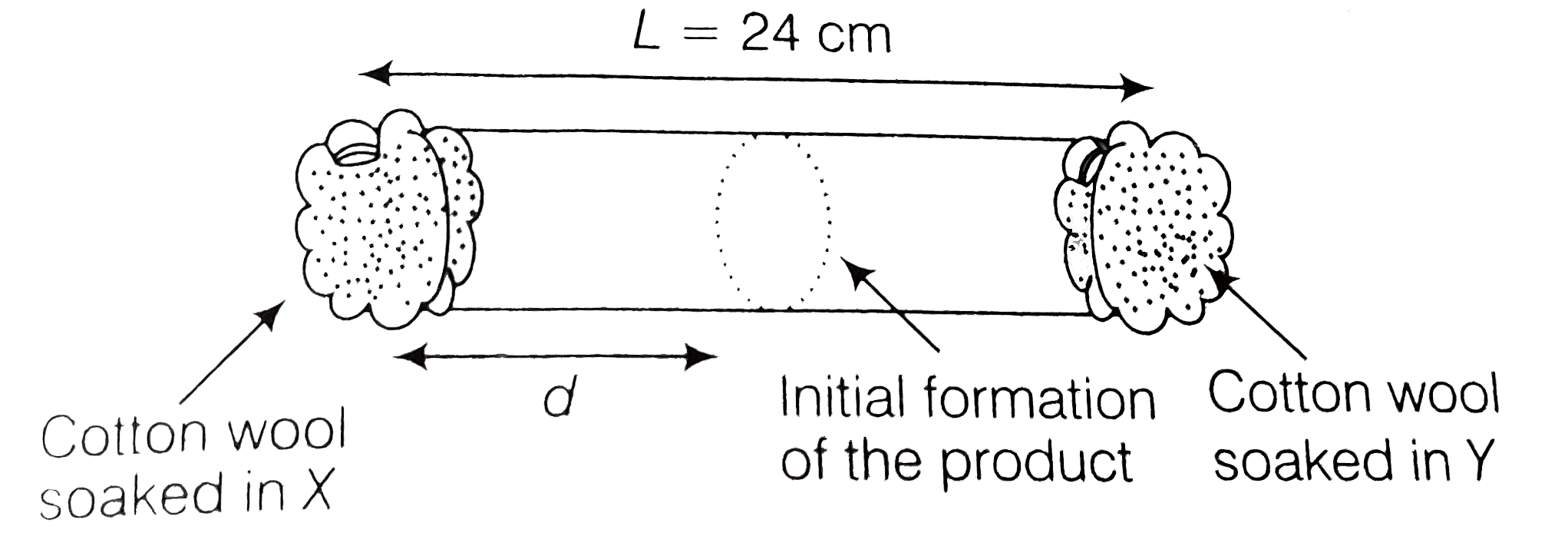At room temperature, ammonia gas at 1 atm pressure and HCl gas at pressure P atm are allowed to effuse through idential pin holes from opposite ends of a glass tube of 1 meter length and of uniform area of cross-section. NH4Cl is first formed at a distance of 60 cm from the end through which HCl gas was sent in. Calculate the value of P.
Since pressure of gases are different, and the temperature is constant, the rate of diffusion of gases is directly proportional to their pressure.
r1r2=p1p2=√M1M2
For ammonia : p1=1 atm
M1=17
For hydrogen chloride : p2=P
M2=36.5
r1=40t,r2=60t
40t60t=1P√36.517
P=6040√36.517
=2.198atm
Topper's Solved these Questions
- STATES OF MATTER : GASES AND LIQUIDSBOOK - MODERN PUBLICATIONCHAPTER - STATES OF MATTER : GASES AND LIQUIDSEXERCISE - HIGHER ORDER THINKING SKILLS (ADVANCED LEVEL)
19 Videos
- STATES OF MATTER : GASES AND LIQUIDSBOOK - MODERN PUBLICATIONCHAPTER - STATES OF MATTER : GASES AND LIQUIDSEXERCISE - COMPETITION FILE OBJECTIVE TYPE QUESTIONS (A. MULTIPLE CHOICE QUESTIONS)
41 Videos
- STATES OF MATTER : GASES AND LIQUIDSBOOK - MODERN PUBLICATIONCHAPTER - STATES OF MATTER : GASES AND LIQUIDSEXERCISE - Revision Exercises (Objective Questions)(Long Answer Questions)
8 Videos
- SOME BASIC CONCEPTS OF CHEMISTRY BOOK - MODERN PUBLICATIONCHAPTER - SOME BASIC CONCEPTS OF CHEMISTRY EXERCISE - COMPETITION FILE (INTEGER TYPE AND NUMERICAL VALUE TYPE QUESTIONS)
10 Videos
- STRUCTURE OF ATOMBOOK - MODERN PUBLICATIONCHAPTER - STRUCTURE OF ATOMEXERCISE - Unit Practice Test
13 Videos
Similar Questions
At room temperature, ammonia gas at 1atm pressure and hydrogen chloride gas at Patm pressure are allowed to effuse through identical pin holes from opposite ends of a glass tube of 1m length and of uniform cross- section. Ammonium chloride is first formed at a distance of 60cm from the end through which HCl gas is sent in. What is the value of P?
View SolutionAt room temperature, NH3 gas at 1 atm and HCl gas at P atm are allowed to effuse through identical pinholes from oppoite ends of a glass tube of 1 metre length and uniform cross section. NH4Cl is first fomed at a distance of 60 cm from the end through whieh, HCI gas is sent in. What is the value of P?
View Solution
Knowledge Check
10 mole of ideal gas expand isothermally and reversibly from a pressure of 10atm to 1atm at 300K. What is the largest mass which can lifted through a height of 100 meter?
A31842kgB58.55kgC342.58kgDnone of theseX and Y are two volatile liquids with molar weights of 10gmol−1 and 40gmol−1 respectively. Two cotton plugs, one soaked in X and the other soaked in Y, are simultaneously placed at the ends of a tube of length L=24 cm, as shown in the figure.
The tube is filled with an inert gas at 1 atm pressure and a temperature of 300K. Vapours of X and Y react to form a product whichh is first observed at a distance dcm from the plug soaked in X.
Take X and Y to have equal molecular diameters and assume ideal behaviour for the inert gas and two vapours.

The value of d in cm (shown in figure), as estimated from Graham's law, isA8B12C16D20
At room temperature, ammonia gas at 1atm pressure and hydrogen chloride gas at Patm pressure are allowed to effuse through identical pin holes from opposite ends of a glass tube of 1m length and of uniform cross- section. Ammonium chloride is first formed at a distance of 60cm from the end through which HCl gas is sent in. What is the value of P?
View SolutionTwo gases NO and O2 were introduced at the two ends of a 1m long tube simultaneously ( tube of uniform cross-section) . At what distance from NO gas end , Brown fumes will be seen.
View SolutionThrough the two ends of a glass tube of length 200cm hydrogen chloride gas and ammonia are allowed to enter At what distance ammonium chloride will first appear ? .
View Solution16 mL of He gas effuses through a pin hole in 4 sec from a container having PHe equal to 1 atm. If same container is filled with CH4 having pressure 2 atm, how much volume (in mL) of CH4 will be leaked through same pin hole in 2 sec?
View SolutionA gas is enclosed in a vessel at a constant temperature and at a pressure of 2 atm and volume 4 liters. Due to a leak in the vessel after some time the pressure is reduced to 1.5 atm as a result if 5P% of the gas escaped out then find the value of P.
View Solution5 moles of an ideal gas expand isothermally and reversible from a pressure of 10 atm to 2 atom at 300K. What is the largest mass which can be lifted through a height of 1 metre in this expansion?
View Solution
